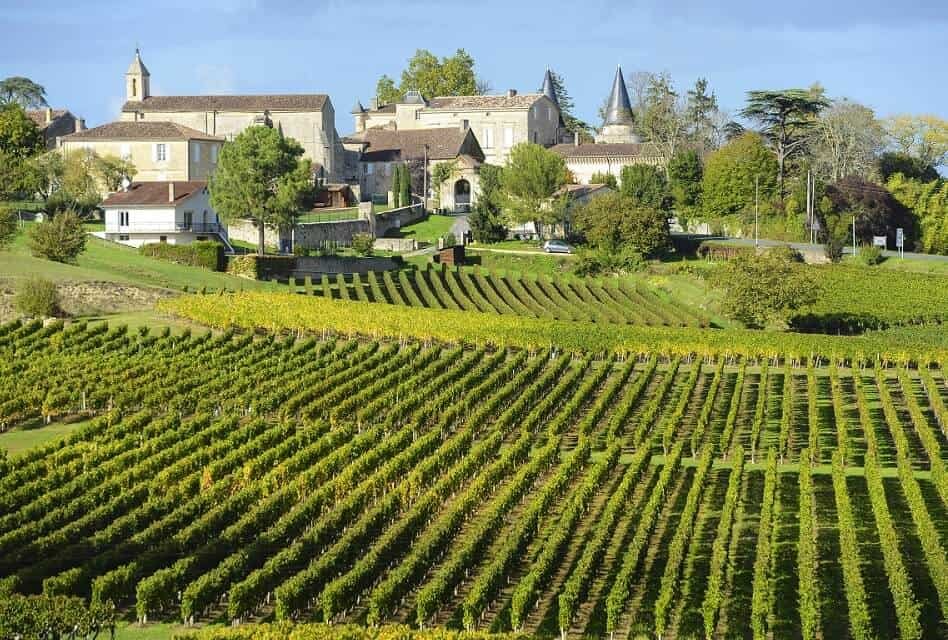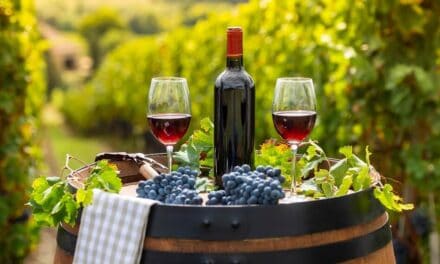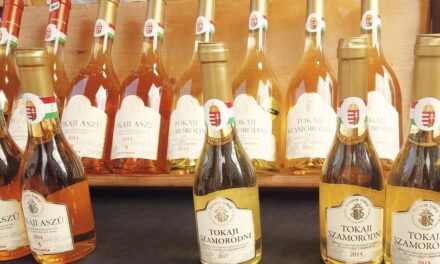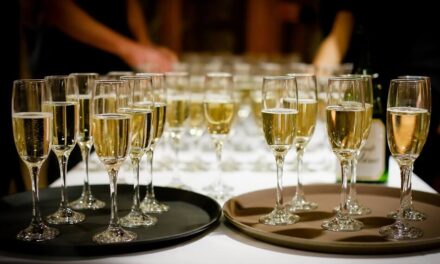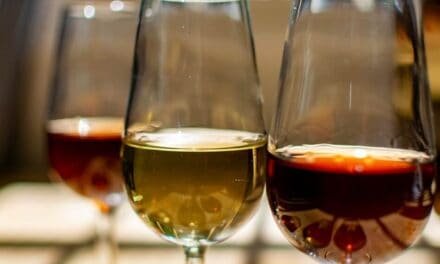The most prestigious Bordeaux wines are red, dry, full-bodied, and feature a complex set of flavors. Most of them have great aging potential and improve constantly over the course of years or even decades.
Bordeaux wines can also be white and there are even outstanding sweet Bordeaux wines that are absolutely worth trying. In the following paragraphs, we will discuss all of these wines in detail.
Where Does Bordeaux Wine Come From?
Bordeaux wines come from the region with the same name: Bordeaux. It is located in South-Western France, bordering the Atlantic Ocean. The vineyards, producing the famous Bordeaux wines are located along the Gironde river, which divides the region into the left bank, and the right bank. This divide is not only geographical but also manifests in vintners’ preferences for grapes and winemaking techniques.
The Left Bank of Bordeaux
The primary grape for left-bank Bordeaux wines is Cabernet Sauvignon. In addition, vintners use Merlot, Cabernet Franc, and Petit Verdot to balance their wines. The soils on the left bank are gravel-based, which allows for better drainage and results in wines with more tannic structures and a longer aging potential. Some of the most famous left-bank appellations are Médoc, Saint-Julien, Pauillac, and Margaux.
The Right Bank of Bordeaux
Right-bank Bordeaux wines are made primarily from Merlot grapes, with smaller amounts of Cabernet Franc and Cabernet Sauvignon. The clay soils on the right bank help to retain moisture and produce fuller-bodied wines with softer tannins. Saint-Émilion and Pomerol belong to the most prestigious appellations of Bordeaux’s right bank.
Right Bank Wines vs. Left Bank Wines
Overall, right-bank Bordeaux wines tend to be more approachable and fruity in their youth, while left-bank Bordeaux wines tend to be more structured and tannic, requiring longer aging to fully develop. However, there are exceptions to these generalizations, and the styles can vary greatly within each bank depending on the specific appellation, vineyard location, and winemaking techniques used.
The History of Bordeaux Wines
The history of Bordeaux wines can be traced back to the Roman Empire when the region was known for producing high-quality wines. However, it was not until the Middle Ages that Bordeaux became a major player in the wine trade. In the 12th century, the English became one of the biggest buyers of Bordeaux wines, and this trade relationship continued for several centuries.
During this time, the wine trade became more organized, with the establishment of wine merchants called “negociants”, who would purchase wine from various vineyards and sell it to customers around the world. The Bordeaux wine classification system was also established during this time.
In the 20th century, Bordeaux wines faced several challenges, including two world wars, the Great Depression, and the phylloxera epidemic that devastated vineyards across Europe. However, the region’s wine industry managed to rebound. today, Bordeaux is one of the world’s most famous and prestigious wine regions with more than 8,000 vineyards and an output of around 700 million bottles per year.
What Is Bordeaux Wine Made From?
Bordeaux wine is typically a blend of several different grape varieties, with the specific blend depending on the sub-region, vineyard, and winemaking style. The primary red grape varieties are Cabernet Sauvignon, Merlot, Cabernet Franc, Petit Verdot, and Malbec.
On the left bank, Cabernet Sauvignon is the dominant grape variety used in red Bordeaux blends. This is due to the gravelly soil, which is well-drained and encourages the Cabernet Sauvignon grape to produce tannic, full-bodied wines with black fruit flavors and herbal notes. Merlot is also used in these blends to add softness, richness, and ripe fruit flavors.
On the right bank, Merlot is the dominant grape variety used. The clay soils on this side of the estuary are better at retaining water, which leads to wines with softer tannins and fruitier, more approachable flavors. Cabernet Franc grapes are also used in these blends to add complexity and structure.
White Bordeaux wines are typically made from a blend of Sauvignon Blanc, Semillon, and Muscadelle grapes. Sauvignon Blanc adds a bright, zesty acidity and citrus notes to the wine, while Semillon adds body and richness. Muscadelle is used in smaller quantities to add floral aromas and complexity to the blend.

Cabernet Sauvignon Grapes
Overall, the exact blend of grapes used in Bordeaux wines can vary widely, depending on the specific vineyard and winemaking style. However, the winemaker’s goal is always the same: Creating a wine that is balanced, complex, and expresses the unique terroir of the estate.
How Is Bordeaux Wine Made?
Bordeaux wine is made using traditional winemaking techniques that have been refined over centuries. The region’s winemakers are known for their meticulous attention to detail to produce some of the most renowned wines in the world. While the specific winemaking process can vary depending on the estate, the following overview gives a good impression of how Bordeaux wine is made:
- Harvesting: The grapes are typically harvested by hand in Bordeaux, as this allows for better selection and sorting of the grapes. Harvesting usually takes place from late September to early October for red wines, and from late August to early September for white wines.
- Sorting: After the grapes are harvested, they are sorted to remove any damaged or unripe grapes. This is an important step to ensure that only the best grapes are used in the wine.
- Crushing and fermentation: The grapes are then crushed, and the juice is fermented in stainless steel or concrete tanks. For red wines, the grapes are fermented with their skins, which adds color, tannins, and flavor to the wine. For white wines, the grapes are usually pressed before fermentation to separate the juice from the skins.
- Malolactic fermentation: After the primary fermentation is complete, the wine undergoes a secondary fermentation called malolactic fermentation. This process converts the sharp-tasting malic acid in the wine to the softer-tasting lactic acid, which adds richness and complexity to the wine.
- Aging: After fermentation, the wine is aged in oak barrels for several months to several years, depending on the style of the wine. This allows the wine to develop additional flavors and aromas from the oak, as well as soften and integrate the tannins.
- Blending: After aging, the wine is blended with other wines from the same vineyard or sub-region to create a final blend that is balanced and expressive of the unique terroir of the region.
- Bottling: Finally, vintners bottle their wines and bottle-age them for several more months before release to allow the flavors to fully integrate and develop.
What Do Bordeaux Wines Taste Like?
Bordeaux wines are known for their balance and complexity, and many wine lovers consider them the best wines in the world. While there are some general characteristics that most Bordeaux wines share, they can vary widely in taste depending on the specific sub-region, vineyard, and winemaking style.
Red Bordeaux wines are typically medium to full-bodied, with firm tannins and aromas of black fruits such as blackberry or black currant. Sometimes they also feature a hint of green bell pepper or tobacco. The wines’ tannins can be quite strong and need several years of aging to soften and integrate with the other flavors. During this process, the wine develops additional earthy and leathery flavors as well as aromas of dried fruit.
Can Bordeaux Wines Be White?
While the most famous Bordeaux wines are red, you can also find white Bordeaux wines. They tend to be dry, medium to full-bodied, and have a crisp acidity. Their primary flavors include citrus and green fruits as well as herbal notes. When aged in oak barrels, the wine develops aromas of vanilla, various spices, honey, nuts, or figs.
Can Bordeaux Wines Be Sweet?
The vast majority of Bordeaux wine is dry, but there is a deliciously sweet exception: Sauternes. These sweet Bordeaux wines are full-bodied with high acidity and significant alcohol volumes of 13 to 15%. Because of their outstanding balance, they do not taste overtly acidic or alcoholic, though. Most Sauternes wines feature intense fruity flavors, including citrus, apricot, mango, or peach. They typically also showcase nutty, spicy, and floral notes.
How to Serve Bordeaux Wines
Because of their complexity, serving Bordeaux wines requires some preparations. You need to take care of temperature aeration to allow the wines to present all of their aromas. And you should also have the proper glassware at hand to provide the perfect drinking experience.
What Is the Best Glass for Bordeaux Wine?
The best glass for Bordeaux wine is a tall, tulip-shaped glass with a wide bowl and a tapered rim. The wide bowl allows the wine to breathe, soften its tannins, and release all of its delicate aromas. The tapered rim helps to focus the aromas toward the nose, while the tall shape of the glass directs the wine to the right spot of your tongue, enabling its flavors to shine.
What Is the Optimal Serving Temperature for Bordeaux Wines?
The optimal serving temperature for red Bordeaux wine is between 60 and 68°F (16 – 20°C). Younger red Bordeaux wines, which are more fruit-forward and have stronger tannins, are generally served at the lower end of this temperature range, around 60 to 64°F (16 – 18°C). For older red styles, which are more complex and have softer tannins, choose the higher end of the range of around 66 to 68°F (19 – 20°C).
White Bordeaux wines, which are typically dry and crisp, should be served at a slightly cooler temperature than reds: 46 to 50°F (8 – 10°C) is fine for younger wines and 52 to 54°F (11 – 12°C) for older bottles.

Raye Crystal Bordeaux Glasses $25.99
$64.97
from: Wine.com
Should You Decant Bordeaux Wines?
Whether decanting benefits Bordeaux wines depends on their age and style.
In general, younger Bordeaux wines with strong tannins do benefit from decanting, as it helps to soften the tannins and open up the wine’s aromas. Let the wine breathe for at least 30 minutes before serving. If it is very tannic, extend the aeration period. In some cases, decanting a wine for several hours or even overnight might be the right approach to optimizing its flavor.
In contrast, older Bordeaux wines, which are typically more delicate and have softer tannins, may not benefit from decanting. Actually, they might even lose some of their complexity and nuance if exposed to too much oxygen.
How to Store Bordeaux Wines
Proper storage is crucial for preserving the quality of Bordeaux wines over time. Here are some tips for storing Bordeaux wines:
- Keep the bottles horizontal: Bordeaux wine bottles should be stored on their side so that the wine stays in contact with the cork. This helps to prevent the cork from drying out and allows it to stay in contact with the wine, preventing air from entering the bottle.
- Store in a cool, dark place: Bordeaux wines should be stored in a place with a consistent temperature between 50 and 59°F (10 – 15°C). The storage area should also be dark to prevent light exposure, which can cause the wine to age prematurely and lose its flavor.
- Maintain proper humidity: The ideal humidity for storing Bordeaux wines is between 70 and 80%. This helps to keep the corks from drying out and prevents air from entering the bottle.
- Avoid vibration: Bordeaux wines should be stored in a place where they won’t be disturbed by vibration. This can cause the sediment to be disturbed and make the wine taste gritty.
- Keep away from strong odors: Wines can absorb odors from their surroundings, so they should be stored away from strong-smelling items such as cleaning supplies or food.
By following these storage guidelines, you can help to preserve the quality and flavor of your Bordeaux wines for years to come.
How Long Does Bordeaux Wine Last When Open?
Once opened, Bordeaux wine can last for a few days to a week depending on the style of the wine, storage conditions, and how much air it is exposed to.
Younger, fruit-forward wines with higher levels of acidity and tannins can last for three to five days after opening, while more mature Bordeaux wines with softer tannins keep for up to a week.
To extend the life of an open bottle, it is important to store it properly. Re-cork the bottle and store it in a cool, dark place such as a wine fridge or cellar. You can also use a wine pump, a gas spray, or a wine-preserving system to create optimal storage conditions.
It is worth noting that as time goes on, the wine may lose some of its flavor and aroma, and the tannins may become softer. Therefore, better consume an open bottle of Bordeaux wine within a few days of opening it to fully enjoy its flavors and aromas.
Can Bordeaux Wine Go Bad?
Like all wines, Bordeaux can go bad if not stored properly. Here are some signs that a bottle of Bordeaux wine may have gone bad:
- Smell: If the wine smells musty, moldy, or like vinegar, it has likely gone bad. A slightly funky or earthy aroma can be normal for some aged Bordeaux wines, but if the smell is off-putting, the wine may be spoiled.
- Taste: Sour, bitter, or metallic tastes are a clear indicator of spoilage.
- Appearance: While a bit of sediment is normal in aged Bordeaux wines, a wine that looks cloudy or has a brownish color is probably not drinkable anymore.
- Cork: If the cork is cracked, dried out, or moldy, chances are high, that too much air has invaded the bottle and ruined the wine. A wet or stained cork can also be a sign of a leak.
Can Bordeaux Wine Be Aged?
Bordeaux wine is known for its aging potential and many styles are made to be aged for years or even decades. Aging allows the wine to develop more complex flavors and aromas, and for the tannins to soften and integrate with the wine.
Generally, the most age-worthy Bordeaux wines are made from high-quality Cabernet Sauvignon, Merlot, Cabernet Franc, Petit Verdot, and Malbec grapes. They come from the best and most prestigious vineyards in the region. In many cases, the vintners indicate a recommended drinking window, during which the wine is at its peak.
It is worth noting that some Bordeaux wines are meant to be consumed when young and fresh. Therefore, it is important to do research on the specific wine or vintage before deciding about aging it or not.
Bordeaux Wine Food Pairing
Bordeaux wines are known for their complexity and versatility when it comes to food pairing. With their good acidity, tannins, and fruit flavors, they complement a wide range of dishes. Naturally, the best pairings come from the French Cuisine. Here are some classic Bordeaux wine and food pairings:
Bordeaux red wines, particularly those from the left bank, pair well with red meat dishes such as lamb and beef. The tannins in the wine help to cut through the richness of the meat and complement the flavors.
Bordeaux white wines from Sauvignon Blanc grapes are fantastic with seafood, including oysters, scallops, and grilled fish. Their crisp acidity help enhance the seafood’s flavors while the citrus adds another layer of aromas to the mix.
Both types can also pair well with roasted vegetables, mushrooms, and other meals that feature earthy flavors. Richer preparations call for red wines with good tannin levels, while lighter meals are better with white wines.
Bordeaux Wine Shopping Tips
Shopping for Bordeaux wines can be a little complicated. The reason is that bottles from the regions usually do not state “Bordeaux” on their label. Instead, they name the sub-appellation. To ensure you actually get a high-quality Bordeaux wine, consider the following appellations:
- Médoc is home to some of the most famous Bordeaux wine châteaux, including Château Margaux, Château Latour, and Château Mouton Rothschild.
- Saint-Émilion is located on the right bank of the Gironde estuary, producing red wines made primarily from Merlot grapes. The appellation is known for its elegant, full-bodied wines, and includes some of the most prestigious châteaux in Bordeaux, such as Château Cheval Blanc and Château Ausone.
- Pomerol also is located on the right bank. Its wines are known for their richness, depth, and complexity. Especially wines from Château Pétrus and Château Le Pin are sought-after Bordeaux wines
- Graves produces both red and white wines and is home to some of the oldest Bordeaux wine estates, such as Château Haut-Brion.
- Sauternes in the southern part of Bordeaux is well-known for its sweet white wines made from botrytized Semillon and Sauvignon Blanc grapes.
- Margaux is a sub-region of the Médoc appellation. The appellation is famous for its elegant, fragrant red wines made- Look out for wines from Château Margaux or Château Palmer.
- Pessac-Léognan is a small sub-appellation of Graves. You can find both red and white wines from this area. The most prestigious estates from Pessac-Léognan are Château Haut-Brion and Château La Mission Haut-Brion.
- Saint-Julien is another sub-region of Médoc, making primarily red wines. They are well-structured, balanced, and age-worthy. Estates to look for are Château Léoville Las Cases and Château Ducru-Beaucaillou.
- Saint-Estèphe is part of the Médoc appellation, too. The red wines from this sub-region are famous for their power, intensity, and longevity. Check out the wines from Château Cos d’Estournel and Château Montrose.
- type: red, still, Vintage
- origin: France, Bordeaux (left bank)
- varietal: Cabernet Franc, Cabernet Sauvignon, Merlot, Petit Verdot
- alcohol: 13.5%
- type: red, still, Vintage
- origin: France, Bordeaux (left bank)
- varietal: Cabernet Franc, Cabernet Sauvignon, Merlot, Petit Verdot
- alcohol: 14.0%
- type: red, still, Vintage
- origin: France, Bordeaux (left bank)
- varietal: Cabernet Sauvignon, Merlot
- alcohol: 13.0%
- type: red, still, Vintage
- origin: France, Bordeaux (right bank)
- varietal: Cabernet Franc, Cabernet Sauvignon, Malbec, Merlot
- alcohol: 15.0%
- type: red, still, Vintage
- origin: France, Bordeaux (right bank)
- varietal: Cabernet Franc, Cabernet Sauvignon, Merlot
- alcohol: 14.0%
- type: red, still, Vintage
- origin: France, Bordeaux (right bank)
- varietal: Cabernet Franc, Cabernet Sauvignon, Merlot
- alcohol: 14.5%
Final Words
The dedication of Bordeaux winemakers to using only the best grapes and following traditional winemaking methods make Bordeaux one of the world’s most prestigious wine regions. Logically, Bordeaux wines are outstanding, highly complex beverages that will bring your wine experience to a new level. So do not miss trying a bottle when you get the chance.

